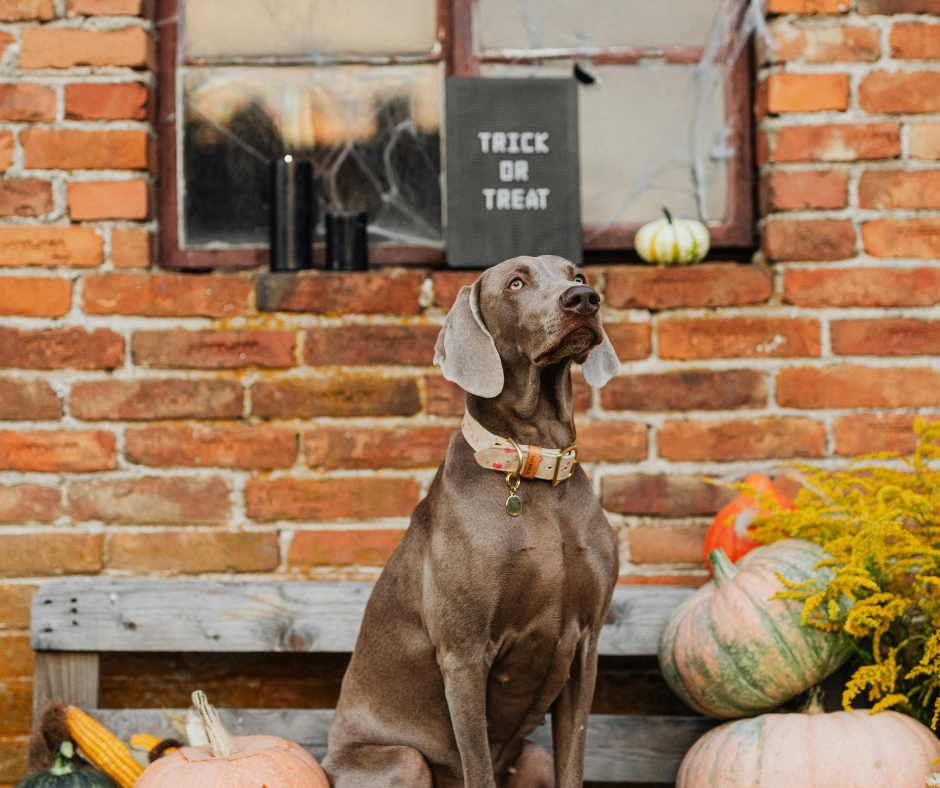Spooks and Sparks: How to Keep Your Pets Safe This Autumn

As the evenings get darker and the weather turns, autumn brings some challenges for our pets. Halloween and Bonfire Night can be particularly stressful for many animals. We’re going to look at the best ways to keep your pet safe during this autumn’s festivities, with some practical tips and advice.
Halloween
Parties and visitors
With Halloween growing increasingly popular, the UK is witnessing a surge in parties and events. While this can be fun for us, it may not be that great for our pets. Many animals can feel anxious about strangers knocking at the door or loud gatherings in their home.
If you are planning on hosting a party, make sure to keep your animals in a quiet, undisturbed area of the house with some familiar possessions. Calming pheromone products can be helpful for many cats and dogs too. However, you may decide that your pet would be happier staying at a friend’s or pet sitter’s house while you host your event instead.
If your pet gets wound up by people knocking at the door, think about leaving a bowl of treats outside for trick-or-treaters instead.
Decorations
Decorating your house for Halloween is not without risk – curious cats and playful pups can easily get into mischief! Try and keep decorative items well out of reach to avoid them being accidentally chewed or swallowed. Intestinal blockages are a serious consequence that often requires emergency surgery to resolve. Make sure your pet is never left unsupervised with decorations and try and distract them if they show a little too much interest.
Trailing electrical wires are an electrocution risk for all pets, but especially rabbits and rod ents that love chewing, so make sure these are tidied away.
Plus, don’t forget, burning candles and pets don’t mix! Again, keep lit candles well out of reach or use battery-operated candles instead. You should also be careful when burning essential oils, as while we may enjoy that pumpkin-spiced smell, it can irritate some pets’ airways and be toxic if accidentally consumed.
Food
Halloween means lots of sweets and chocolates! Unfortunately, chocolate can be extremely toxic for our pets. Chocolate toxicity is dose-dependent, however, meaning that smaller pets will be more at risk of side effects. Darker chocolates also contain higher levels of theobromine than milk or white versions. This compound, found in cacao beans and related to caffeine (also toxic to dogs and cats!), is safe for us but not for our cats and dogs. If your pet has accidentally eaten some chocolate, you could try checking the or contact us for advice.
It’s not just chocolate that’s the problem; sweets are also hazardous. Many sweets could be a choking hazard, especially for small dogs and puppies. Some sugar-free varieties could even be toxic. Xylitol is an artificial sweetener found in many sugar-free sweets, gums, and medicines, which can have some very serious side effects for dogs. If you think your pet has eaten something they shouldn’t have, you must contact the practice immediately on 0151 428 8600.
Costumes
We don’t recommend dressing animals up at Halloween. Costumes can be uncomfortable, cause anxiety, and may even lead to some pets overheating. When it comes to pet clothing, always think function over style. If your pet’s outfit has a purpose, such as a well-fitting waterproof jacket for dog walking or a functional jumper to keep the chill away for hairless breeds, then that’s fine. However, outfits for decorative or comedy purposes should be avoided. As cute as your pet might look, most cats and dogs really don’t enjoy being dressed up.
Bonfire Night
We know that fireworks can be extremely stressful for many pets, especially with events taking place on more than one night. Anxious pets may show the following signs:
- Pacing or restlessness
- Panting
- Excessive drooling
- Hiding away
- Inappropriate toileting
- Destructive digging and chewing
Sound desensitisation training from a young age is the best way to reduce the risk of noise phobias, but it’s never too late in life to start this. Training involves playing recordings of firework sounds at very low volume, increasing this over time, but checking that your pet is comfortable with each gradual volume change. This process should take place well ahead of Bonfire Night.
As well as training, there are some other things you can do to help your pets:
- Walk your dog earlier in the day and stay inside when it gets dark. You should also consider giving them an extra-long walk or play session to help tire them out. This may help your pet to feel more settled by the time the fireworks start in the evening.
- Lock the cat flaps, keeping your cat indoors with a litter tray.
- Close windows and curtains
- Play some gentle background television or radio to help mask fireworks sounds.
- Set up a den or hiding place for your pet to retreat to. This should be introduced several days in advance so that your pet has time to explore it before Bonfire Night. A blanket draped over some chairs works well, or putting a cover on top of their usual crate if they are crate trained. You could put their favourite toys and treats inside to encourage them to use this area.
- Offer distraction with puzzle feeders and snuffle mats.
- Use calming pheromones or anti-anxiety supplements. These are usually best started ahead of Bonfire Night, so check the manufacturer’s instructions.
If your pet is extremely anxious, you may wish to come in and talk to us. We can discuss some of these management techniques in more detail, as well as whether any prescription medications would be appropriate for your pet.
And a couple of other things…
Make sure your pet is microchipped
Microchipping is a legal requirement for both cats and dogs. It’s a way of identifying your pet and reuniting them with you if they go missing. Pets can get spooked and run away because of things like Halloween celebrations or fireworks. Make sure your details are up to date on the microchip database so that you can be easily contacted when your pet is found.
Don’t forget small furries!
Rabbits and guinea pigs can also get upset by fireworks, so don’t forget them this autumn. Try and move them indoors if possible or keep them confined in their sleeping quarters while fireworks are taking place. You can insulate the hutch from sounds with a thick blanket and by providing extra bedding, just make sure that your pet still has some ventilation. Make sure they have their usual companion to snuggle up with as well.
If you follow our top tips, you and your pets should be able to enjoy the autumn celebrations safely. Don’t forget to contact us if you have any concerns about your pet’s health or behaviour, and we’ll arrange an appointment to see you.



